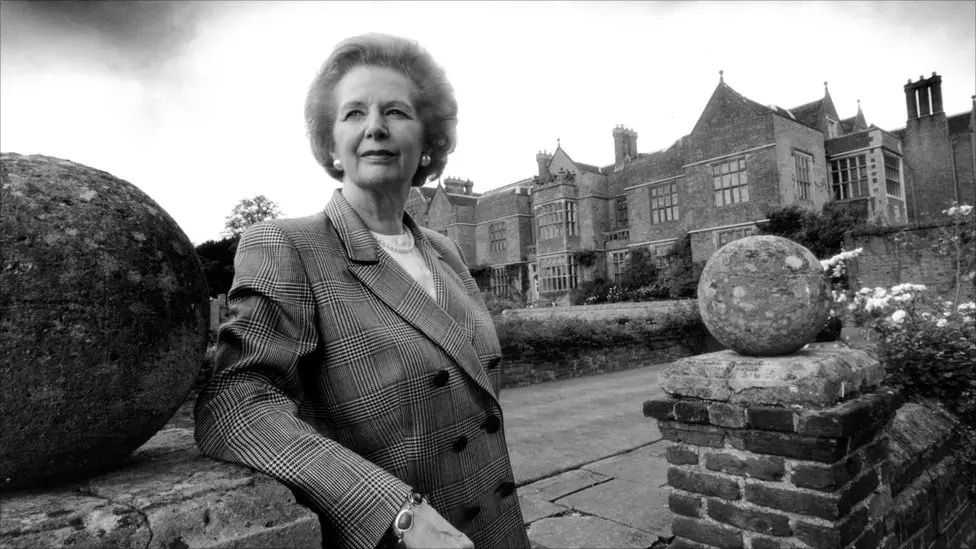Accueil>The long shadow of Thatcherism

07.11.2025
The long shadow of Thatcherism
The 13th of October 2025 marks the 100th anniversary of the birth of Margaret Thatcher, Britain’s most controversial and arguably most significant Prime Minister of the post-war period. A century on from her birth and a half-century on from her ascent to the Conservative Party leadership in 1975 we can finally begin to assess her legacy with some of the perspective that hindsight affords.
Set in any historical context that legacy is considerable. Thatcher is, of course, the only British Prime Minister of the long 20 th century and the present century to have given rise to an ‘-ism’ that has stuck. All of the others – Major and Blair perhaps most recently – were fleetingly accorded ‘-ismic’ status. But that status endured only for as long as they were in office and was almost immediately withdrawn the moment they left office. Significantly, ‘Majorism’ and ‘Blairism’ only seemed relevant in comparison with Thatcherism; and both paled in comparison to Thatcherism. No-one is going to speak of Starmer or Truss, Sunak, May or Johnson in ‘-ismic’ terms. In short, Thatcher’s government is the only government of the post-war period to merit such an epithet.
Yet there is a certain irony here – indeed, perhaps two.
The crucial test of a genuine ‘ism’ is ideological coherence – something, of course, that both Major and Blair were singly seen to lack. But, and herein lies the first irony, although Thatcherism can hardly be seen to lack ideological purity, Thatcher herself was in no sense the intellectual architect of Thatcherism. She certainly came to personify the ‘ism’ to which her name has given rise. And she did so in such a way and to such an extent that Thatcherism would not have been possible without Thatcher. But she did so only performatively. She embodied Thatcherism and, in the process, reinvented conviction politics in Britain; but she was not the source of the ideas she came to personify.
Those ideas, a flexible and at times strategic combination of neoliberal and neoconservative themes, served as targeting devices informing the Blitzkrieg her governments would launch on the post-war settlement. Where the crosswires of the twin targeting devices lined up – where, in short, the neoconservatives and neoliberals found a common grievance – Thatcherism was at its most radical. Nowhere was this more obvious than in its brutal assault on the generosity of a welfare state that was both market-distorting (for neoliberals) and paternalistic (for neoconservatives). Where, by contrast, the moral authoritarianism of neoconservatism and the new market purism of neoliberalism diverged, Thatcherism was far less active.
The second irony is that for a long time the much searched for ‘Thatcher effect’, as it was called, seemed elusive to political scientists and psephologists. The electorate, they concluded at the time, was not becoming Thatcherite.
That was then. For with hindsight, the nature and the extent of the Thatcher effect and its legacy has become increasingly clear – a legacy that, in effect, confirms retrospectively that we were right at the time to think that we were indeed in the presence of a new ‘ism’.
That legacy is both political and socio-economic – and in each respect utterly transformatory.
Politically, as detailed time-series analyses of the evolution of public opinion now show clearly, the Thatcher effect turns out to have been what is called a ‘cohort’ effect. Put simply, ‘Thatcher’s children’ think differently from their parents, above all when it comes to their views on the economy. Indeed, what is perhaps more interesting still is that ‘Blair’s babies’ are, in a way, yet still more neoliberal in their thinking.
On the face of it that might seem somewhat paradoxical. But it isn’t. For in the presence and under the influence of the Thatcherite conviction politics of the time, all that the government targeted was controversial and contested. Thatcherism divided the population. Yet under Blair much of Thatcherite neoliberalism became normalised – the new normal of the post-Thatcher but far from post-Thatcherite consensus. Those who came of political age in the context of this emerging governing orthodoxy were no longer capable of identifying an alternative. In short, if many of Thatcher’s children were political converts to normative neoliberalism, rather more of Blair’s babies were normalised neoliberals. This all but guaranteed the consolidation of the Thatcherite legacy.
No less significant is Thatcherism’s economic and socio-economic bequest. Again, with the benefit of hindsight, what was rather more opaque at the time is now crystal clear. Indeed, it is stark in its clarity – with 1979 (the date of Thatcher’s first election) the tipping point in the data series. Beyond this point, pre- and post-tax income inequality and, more starkly still, wealth inequality – all of which had been falling consistently since the 1950s – start to rise. They have risen ever since – exponentially, in the case of wealth inequality.
There are a number of factors at work here. The first is the effect of cumulative fiscal reform, with the taxation system increasingly stripped of the redistributive elements put in place in the early post-war years to fund the welfare state. The second is welfare retrenchment itself – with 1979 again emerging as a tipping point after which welfare benefits become ever less generous to those eligible to receive them and eligibility criteria ever stricter. Finally, and most decisively, are the combined effects arising from the liberalisation and deregulation of the banking sector, the expansion of home ownership, the liberalisation of the mortgage market and the eventual establishment of a low interest rate – low inflation rate equilibrium with the growing influence of monetarism on monetary policy (enshrined in the terms of operational independence for the Bank of England under Blair).
The result has been an unprecedented and sustained period of asset appreciation, benefitting of course those with existing assets (notably property) and those with access to the credit to acquire such assets (typically through the mortgage market) – and benefitting them in proportion to the value of those assets. The already rich have become a great deal richer at the expense of the asset-poor and asset-free. To give a sense of the magnitude of the effects present here, in the years prior to the global financial crisis, the average annual increase in the value of the average home was greater than pre-tax average annual income.
The result has been a profound and still ongoing economic polarisation and the political consequences arising from that. On the one hand we have the asset rich and those with access to mortgage finance, who have seen a near exponential increase in the value of their net wealth. On the other hand, we have a new precariat, those with low or no income and no assets reliant on the rental sector.
Britain today is more economically divided than it has ever been. And that legacy, a legacy ultimately of Thatcherism, is arguably responsible for the increasingly angry politics of the pre- and post-Brexit period. It is manifest – indeed, viscerally present – today in the rise of UKIP (as it was) and Reform (as it is), bolstering its support through the authoritarian populist mobilisation of the anguish and frustrations of the new precariat.
A century on from the birth of Thatcher we are still living with the legacy of the Thatcherism that she inspired and personified. Its shadow casts an increasingly dark pall over an ever more divided nation.
